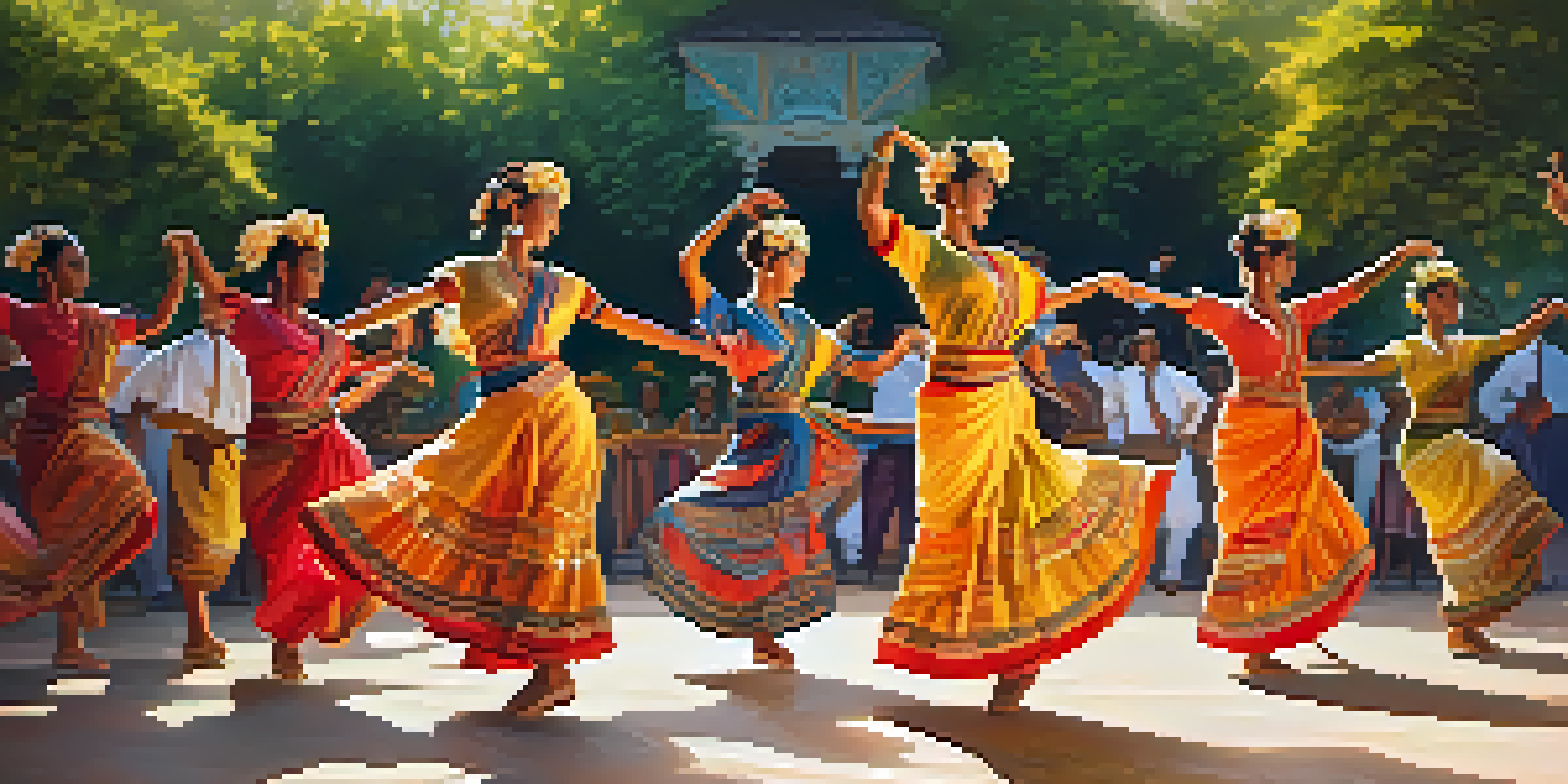Cultural Dance Practices and Their Mental Health Impact

Understanding Cultural Dance: A Rich Heritage
Cultural dance is more than just movement; it's a vibrant expression of history and identity. From traditional folk dances to modern interpretations, these practices reflect the values and stories of communities around the world. Engaging in cultural dance allows individuals to connect with their roots, fostering a sense of belonging and pride.
Dance is the hidden language of the soul.
Each dance form carries unique significance, often tied to rituals, celebrations, or storytelling. For example, the intricate footwork of Irish step dancing showcases not only skill but also the cultural narratives of resilience and joy. This connection to heritage can provide a comforting anchor in today’s fast-paced world.
Moreover, participating in these dances offers a way to celebrate diversity and promote understanding. When people engage in cultural dance, they embrace the richness of different backgrounds, paving the way for intercultural dialogue and appreciation.
The Connection Between Dance and Mental Health
Research has increasingly shown that dance can have profound effects on mental health. Engaging in rhythmic movement helps release endorphins, which are natural mood lifters. This biochemical response explains why many find themselves feeling happier and more relaxed after a dance session.

Moreover, dance can serve as a form of expression and release for emotions that may be difficult to verbalize. Whether it's the joy of a celebratory dance or the sorrow expressed through slower movements, dancing allows individuals to process their feelings in a safe environment. This emotional outlet can be particularly beneficial during stressful times.
Cultural Dance Connects Identity
Engaging in cultural dance fosters a deep connection to one's heritage, enhancing self-discovery and community ties.
Additionally, the communal aspect of cultural dance often fosters social connections, which are crucial for mental well-being. Sharing the dance floor with others creates bonds and a sense of community, helping to combat feelings of loneliness and isolation.
Dance as a Form of Therapy: Evidence and Insights
Dance therapy has emerged as a recognized therapeutic practice, leveraging movement to improve emotional, cognitive, and physical well-being. Licensed dance therapists guide individuals through movement exercises tailored to address specific mental health challenges, such as anxiety or depression. This innovative approach underscores the versatility of dance as a healing art.
Dancing is like dreaming with your feet.
Studies have indicated that individuals who participate in dance therapy often report heightened self-esteem and reduced stress levels. For instance, a recent study found that participants in dance therapy experienced significant improvements in mood and emotional regulation. This suggests that the benefits of dance extend beyond mere enjoyment; they can be transformative.
Moreover, dance therapy is adaptable, making it suitable for people of various ages and abilities. Whether in a one-on-one setting or a group environment, the focus on movement fosters a sense of empowerment, allowing individuals to reclaim control over their emotional landscapes.
Cultural Dance: A Tool for Mindfulness and Presence
Practicing cultural dance encourages mindfulness, as participants must focus on their movements and rhythm. This concentration pulls individuals into the present moment, diverting attention from stressors and worries. In this way, dance becomes a form of meditation, helping to quiet the mind and enhance overall mental clarity.
As dancers immerse themselves in the music and choreography, they often experience a state of flow, where time seems to stand still. This immersive experience not only promotes relaxation but also cultivates a deeper appreciation for the art form itself. The result is a rewarding experience that nourishes both the body and the spirit.
Dance Boosts Mental Health
Participating in dance promotes emotional well-being by releasing endorphins and providing a safe outlet for expression.
Furthermore, the repetitive nature of many cultural dance practices can have a calming effect, akin to mindfulness techniques. By engaging in familiar movements, dancers find comfort and stability, reinforcing their mental resilience in challenging times.
The Role of Community in Cultural Dance Practices
Community plays an integral role in cultural dance practices, providing a supportive environment for participants. When individuals come together to dance, they create shared experiences that foster connection and understanding. This strong sense of community can significantly contribute to individual mental health, promoting a feeling of belonging.
Through group dances, participants not only learn from one another but also build lasting friendships. These social ties can act as a buffer against mental health challenges, providing crucial support during tough times. In many cultures, dance gatherings serve as a social glue, reinforcing community bonds that benefit everyone involved.
Moreover, community dance initiatives often encourage inclusivity, inviting individuals from diverse backgrounds to join in. This openness not only enriches the dance experience but also cultivates empathy and appreciation for different cultures, ultimately enhancing collective mental well-being.
Cultural Dance and Identity: A Path to Self-Discovery
For many, engaging in cultural dance is a journey of self-discovery and identity exploration. Through movement, individuals can express facets of their personality that may be hidden in everyday life. This exploration often leads to a deeper understanding of oneself and one's place within a broader cultural context.
As dancers learn the steps and stories behind their cultural practices, they often find a renewed sense of purpose. This connection to one’s heritage can ignite passion and pride, boosting self-esteem and confidence. By embracing their identity through dance, individuals empower themselves to face challenges head-on.
Community Strengthens Dance Practices
The communal nature of cultural dance cultivates social connections, which are essential for individual mental health and resilience.
Additionally, the act of sharing one's culture through dance promotes a sense of responsibility to preserve and celebrate traditions. This commitment not only enriches personal identity but also strengthens community ties, creating a legacy for future generations.
Incorporating Cultural Dance into Daily Life
Incorporating cultural dance into daily routines can be a simple yet effective way to enhance mental well-being. Whether it’s taking a dance class, joining a local cultural group, or even dancing at home, the opportunities are plentiful. Making dance a regular part of life can lead to a healthier mindset and a more joyful outlook.
For those who may feel shy about dancing in public, starting at home can be a liberating experience. Playing music that resonates and allowing oneself to move freely creates a personal space for expression and joy. This individual practice encourages creativity and can be a powerful tool for stress relief.

Furthermore, seeking out local events or festivals that celebrate cultural dance can provide not only enjoyable experiences but also foster community connections. These gatherings allow individuals to engage with their culture while meeting new people, creating a supportive network that enhances mental health.